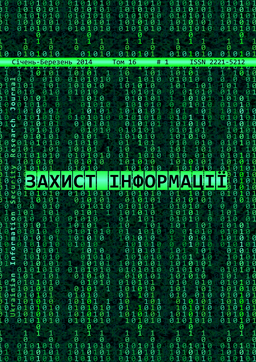Secured network information resource as synergetic system
DOI:
https://doi.org/10.18372/2410-7840.16.6287Keywords:
information resource, secured information resource, website security, information resource model, synergetic, synergetic modelingAbstract
The increasing complexity of modern network infomation resources, the introduction of intelligent program solutions with non-linear relationships between elements requires the use adequate mathematical tools to describe them. Existing approaches are mainly based on the means of systems analysis, cybernetics, game theory - deteminitic mathematical methods. This limits the ability to describe systems with a large number of elements and essentially with non-linear relationships between them, especially in non-equilibrium states, caused by attacks attempting on information resources. A structural model of protected information resources with the architecture conforming to the requirements of normative documentation of Ukraine and standards were proposed. The model shows the main features that are typical for a synergetic system. Application of synergetic mathematical methods will allow describing more qualitatively the processes of system deviation from equilibrium state, detecting features of the system approaches the bifurcation point, and developing tools for system diversion from nonequilibrium states.
References
Грищук Р. В. Р-моделювання процесів нападу на інформацію при нестаціонарній природі потоків захисних дій та інформаційних атак. [Текст] / Р. В. Грищук // Системи обробки інформації, 2009. - випуск 7 (81). - с. 98-101
Висоцька В. Математичні моделі інформаційних потоків у системах електронної контент-комерції [Електронний ресурс] / В. Висоцька // Електронний науковий архів Науково-технічної бібліо-теки Національного університету "Львівська по-літехніка"": — Режим доступу http://ena.lp.edu. ua:8080/bitstream/ntb/8055/1/28.pdf (дата звер-нення: 01.12.13)
Бойко Н. Моделювання web-орієнтованих систем та напрямки розвитку web-ресурсів [Електронний ресурс] / Н.І. Бойко // Електронний архів Національної бібліотеки України імені В. І. Вернадського. — Режим доступу http://archive. nbuv.gov.ua/portal/natural/vnulp/ISM/2012_743/
pdf (дата звернення: 01.12.13)
Ожеван М. А. Синергетика проти кібернетики: конкурентні методологічні підходи до моделювання складних соціальних систем [Текст] / Оже-ван М. А. // Стратегічні пріоритети. — 2012. - № 3 (24). — с. 126-133.
НД ТЗІ 1.1-002-99 Загальні положення щодо захисту інформації в комп'ютерних системах від несанкціонованого доступу. [Text] / НД ТЗІ, за-тверджений наказом ДСТСЗІ СБ України від 28.04.1999 № 22.
НД ТЗІ 2.5-004-99 Критерії оцінки захищеності інформації в комп’ютерних системах від несанкціонованого доступу. [Text] / НД ТЗІ, затверджений наказом ДСТСЗІ СБ України від 28.04.1999 № 22.
НД ТЗІ 2.5-010-2003 Вимоги до захисту інформації WEB - сторінки від несанкціонованого дос¬тупу. [Text] / НД ТЗІ, затверджений наказом ДСТСЗІ СБ України від 02.04.2003 № 33.
ISO/IEC 7498-1:1994(E) Information technology — Open Systems Interconnection — Basic Reference Model: The Basic Model. [Text] / ISO/IEC 7498- 1:1994(E). Second edition. Corrected and reprinted 1996. Switzerland: ISO/IEC Copyright Office. — 68 p.
Страуструп Б. Язык программирования С++. [Текст] / Бьерн Страуструп. — М.: Бином, Невский Диалект. — 2008. — 1104 с.
Хакен Г. Синергетика. [Текст] / Хакен Г. — М.: Мир. — 1980. — 405 с.
Степин В. С. Синергетика и системный анализ. [Текст] / Степин В. С. // Синергетическая парадигма. Когнитивно-коммуникативные стратегии современного научного познания. М.: Прогресс- Традиция. — 2004. — 560 с.
Саридис Д. Н. Самоорганизующиеся стохастические системы управления. [Текст] / Саридис Д. Н. — М.: Наука. — 1980. — 400 с.
R.V. Gryschuk (2009) P-simulation of the attack process on the information with the non-stationary kind of the protective and information attack. Infor¬mation processing systems 7 (81), p. 98-101.
Vysotska V. (2010) Mathematical models of infor-mation streams in e-commerce systems [Online] Sci-entific library of Lviv Polytechnic. Available from http://ena.lp.edu.ua:8080/bitstream/ntb/8055/1/2 8.pdf [Accessed: 1st December 2013].
Boyko N. (2012) Web-oriented systems modeling and web-resources development direction. [Online] E-archive of National Library of Ukraine. Available from http://archive.nbuv.gov.ua/portal/natural/ vnulp/ISM/ 2012_743/02.pdf [Accessed: 1»* De¬cember 2013].
Ozhevan M. A. (2012) Synergetic versus cybernetics: concurrent methodological approach to complex social system modeling. Strategic Priority. 3 (24), p. 126-133.
UKRAINE Security Service of Ukraine (1999) General statements on information security in computer systems from unauthorized access (1.1¬002-99). Kyiv: SSU.
UKRAINE Security Service of Ukraine (1999) Esti-mation criteria of information security in computer systems from unauthorized access (2.5-004-99). Kyiv: SSU.
UKRAINE Security Service of Ukraine (2004) Re-quirements for information security of WEB-page from unauthorized access (2.5-010-2003). Kyiv: SSU.
ISO/IEC 7498-1:1994(E) Information technology - Open Systems Interconnection — Basic Reference Model: The Basic Model. Second edition. Corrected and reprinted 1996. Switzerland: ISO/IEC Copyright Office, 68 p.
BJARNE STROUSTRUP (2008) The C+ + Programming Language. Moscow: Binom.
HERMANN HAKEN (1980) Synergetic Moscow: Mir
Stepin V. S. The synergetic and the system analysis. In ARSHINOV et al. (ed.) (2004) Synergetic paradigm. Moscow: Progress-Tradition.
SARIDIS D. N. (1980) Self-organizing stochastic control systems. Moscow: Science.
Downloads
Issue
Section
License
Authors who publish with this journal agree to the following terms:- Authors retain copyright and grant the journal right of first publication with the work simultaneously licensed under a Creative Commons Attribution License that allows others to share the work with an acknowledgement of the work's authorship and initial publication in this journal.
- Authors are able to enter into separate, additional contractual arrangements for the non-exclusive distribution of the journal's published version of the work (e.g., post it to an institutional repository or publish it in a book), with an acknowledgement of its initial publication in this journal.
- Authors are permitted and encouraged to post their work online (e.g., in institutional repositories or on their website) prior to and during the submission process, as it can lead to productive exchanges, as well as earlier and greater citation of published work (See The Effect of Open Access).

